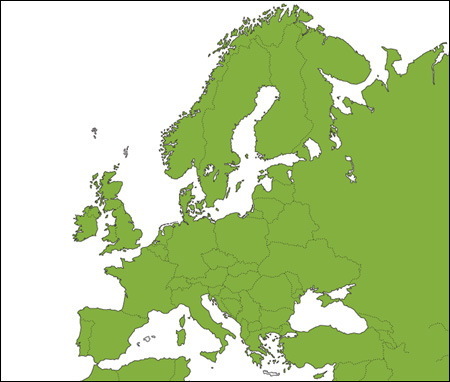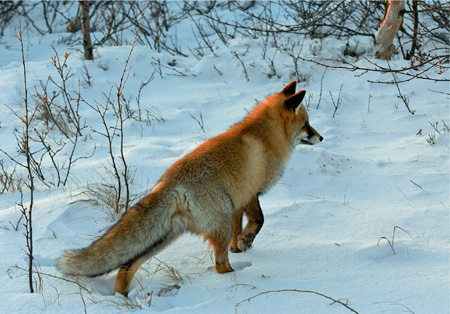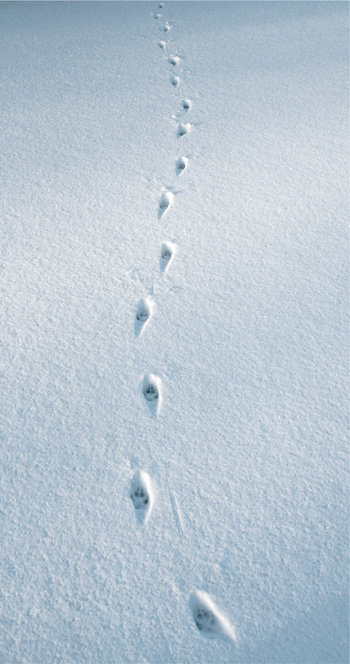
Vulpes vulpes
The back and flanks of Red Fox are reddish or greyish brown, the throat and chest normally white or greyish white, or may be black. The tail ends in a light tip. Red Fox is about 70 cm long, and the tail, about 40 cm. The male weighs about 8 kg, but may reach 15 kg. The female is smaller and weighs about 6.5 kg, rarely reaching 9.5 kg. The height at the shoulder is 35–40 cm.
The Red Fox is most comfortable in open landscapes without thick vegetation, including fields, moorland, and meadows, but it also lives in suburbs and some large cities. You will also find Red Foxes in coastal areas. They are normally active at dusk or at night but regularly seen during the day as well.
The Red Fox lives in an established territory, marked by scat and the animal’s strong-smelling urine. The female fox urinates like a female domestic dog, usually on trails; the male cocks his hind leg, also like a dog.

Foxes can live as loners, but normally they live in family groups comprising the adults, the young, and sometimes one or more individuals of lower ‘rank’.
Red Foxes feed mainly on small rodents, primarily voles, but small birds, pigeons, game birds, and eggs are also on the menu. The fox can also catch grown hares and deer and their young, when the latter are weak or sick. Carrion such as road kill is also readily consumed, and in summer, earthworms, insects, and fruit and berries are eaten as well. Food put out for pets, hedgehogs, or garden birds may also be taken.
A Red Fox listens for mice under the snow. ME.

The tracks of Red Fox look like those of small dogs, but the prints are generally longer and narrower. The fox has five toes on the front foot, but the inner toe is set too high to leave a print. The hind foot has four toes. If one draws a straight line behind the two middle pads they will be parallel or in front of the prints of the two rear and outer pads (cf. p. 10), but in a domestic dog they are parallel to the rear pads (cf. p. 7). The prints of the toe pads are narrower and not as close together as they are for domestic dogs, and the claw prints are sharper than those of a domestic dog.
Fox tracks in snow. LG.

A fox print in sand. LG.

The footprint of a Red Fox is 5–7 cm long and 4–4.5 cm wide, with the front footprint clearer than that of the hind. The claws on the two middle toes of the front foot are more widely splayed than those on the hind foot. The stride is about 60–90 cm.
When the fox moves quietly through snow, it normally places the hind feet in the tracks of the front feet, while a domestic dog often places them slightly askance. On firm terrain, however, the fox can also move with its feet slightly apart the way a dog does, and you will then see two tracks.
A fox has marked its territory with urine. EHA.

Fox scat. ED.

A fox marks its territory by leaving scat in prominent places, one of several strategies for marking. NPHH.

Fox hairs on a barbed wire fence. LG.

Red Fox tracks normally do not follow a straight line, instead showing numerous side steps; a domestic dog moves in more linear fashion.
If a fox regularly passes by a barbed wire fence, you can often find strands of its hair caught on a barb. The colour, length, and texture clearly reveal the identity of the animal (cf. p. 14).
Fox scat is 1.5–2.5 cm wide and 5–10 cm long. It is often segmented, with hair holding the segments together. The scat is lightly twisted and ends in a point. Scat is used to mark territory and often left in prominent places—in the middle of a path, on a stone or a molehill. Fresh scat has a strong odour. The scat contains the remains of the fox’s meal: hair, feathers, fruit stones, insects, and pieces of bone. As time passes, the scat becomes grey and may resemble an owl’s pellet.
Beware! Red Fox scat should not be touched, because it might contain the eggs of a dwarf tapeworm that may be deadly to humans; however, this tapeworm is not as common in northern Europe as it is in central and southern Europe.
The fox gives birth to its young in a den. On open slopes, often with a southern exposure and sandy or gravelly soil, you can see the excavated soil in a long arc below the den’s entrance. The entrance is 25–30 cm wide. There is no rut like the one you might see at the entrance of a Eurasian Badger’s den. The fox may also utilise natural cavities, or build a den between roots or large rocks or in rock crevices. Garden sheds or outhouses may also be used, as well as old Eurasian Badger or Rabbit burrows. When the den is in use, clear tracks and the remains of prey are easily visible, the grass is usually trampled, and there is a discernible smell of fox.
Red Foxes like to rest in front of their den. LG.

Signs of digging. LG.

A fox gnawed on this deer corpse. SSU.

A fox consumes mice and small birds whole. In stubble fields you can see places where a fox has found a mouse’s nest and dug it out to find the young.
Large birds and mammals are often carried to a place where the fox can eat them undisturbed. When it has caught a larger bird, the fox will often chew off the flight feathers.
Larger animals that the fox cannot carry are cached and marked with urine. When a fox eats eggs, it breaks the shell into large pieces and licks out the contents. Eggs are often hidden under moss and plants for later consumption.
The jumps and leaps of a fox are well suited for hunting small rodents. ME.
